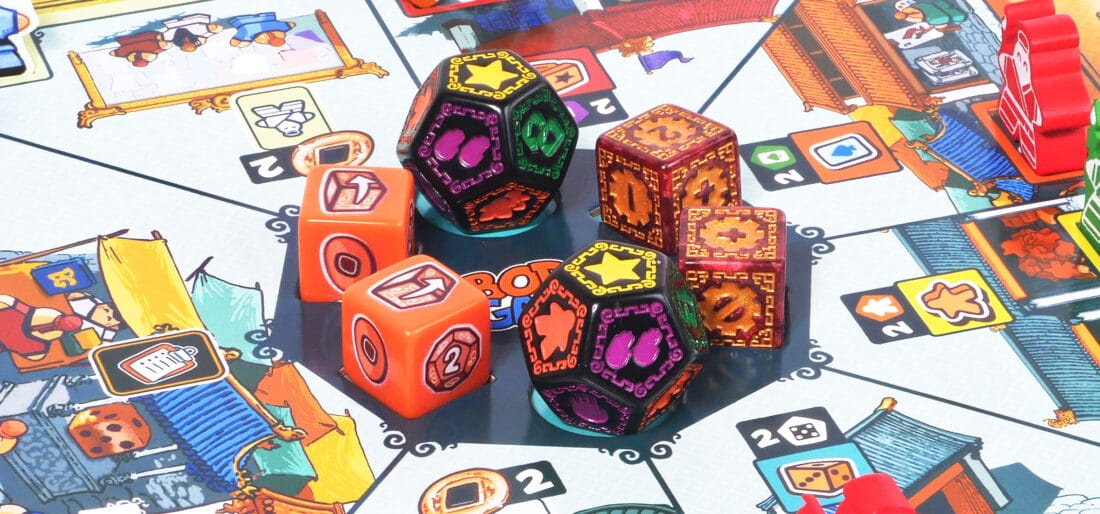
The multiple sides of dice
The multiple sides of dice. Dice are to this day the obvious choice when you need to generate a random number. Although over the past few years board games have developed a lot and with it a vast variety of other mechanisms to create randomized elements in games, few can beat the ease of use along with the reliability of a dice. As such, the majority of board games will have them being used in some shape or form. And they can be customized in many ways. Whether you change the amount of die faces, the colors or the size, you can make it as unique as well as exactly how you want. And let’s not forget: how much fun is it to roll a dice? The excitement of rolling and hoping for that one lucky 6 you need to win!
For a component this important to many games, we of course also had to include it in our sample box. But as said before, there are many different ways to customize a dice. So instead of settling for only one type of custom dice. We designed 3 different ones! In this article, we will explain the different production methods and what to pay attention to in terms of design for each style.
The “resources dice” – Molded resin 12 sided dice
The Boda Games sample box is actually more than just a box filled with sample game components. It itself is also a game! And in the game that we aptly called “The Manufacturer’s Race,” we have several resources that you need to win the game. The first dice we will discuss is a 12 sided one that has custom die faces, as pictured below.
Material choice
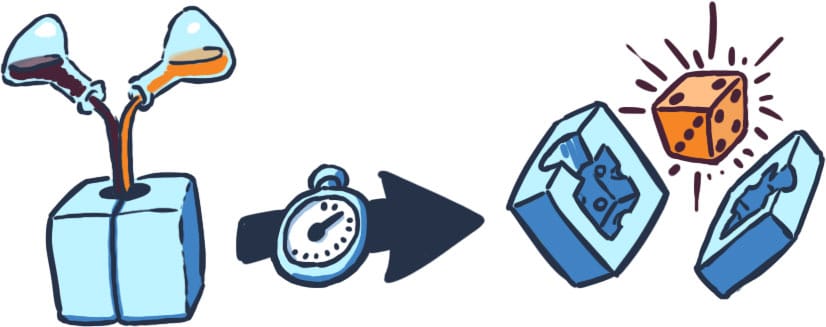
Custom dice can be manufactured according to different manufacturing processes. For this 12 sided custom design, we chose to use a molded resin manufacturing method. With this process, a mold is created first and then that mold gets filled with resin to make the dice. The reason we chose resin and not acrylic for this dice is because resin is slightly harder than acrylic, and therefore you can make more profound and easy to identify details on the dice surface. For the base color, we used a simple black color. The advantage of using black as a base is that it is compatible with any other color for combinations.
Face design

When you design the die faces of a custom dice, you need to keep a few things in mind. First and foremost, the number one rule with die face designs is that lines cannot be too thin. If they are too thin, they are very hard to see and there might be issues with the painting of the lower parts of the die face later on. Another thing that does not work well with these designs is if there are a lot of different elements that are grouped together too closely on the same die face.
The designs in the below image were all made keeping these things in mind. As you can see, although there are some “thinner” elements here and there, they are part of a rounding or oval shape design and not straight lines. We also made sure that different elements were spaced far away from each other to not interfere.
When you send your designs for dice over to your Boda Games account manager, please check in what format you send them. Our preferred file format is a vector file, that can be made either in .ai or as a .pdf.
Colors
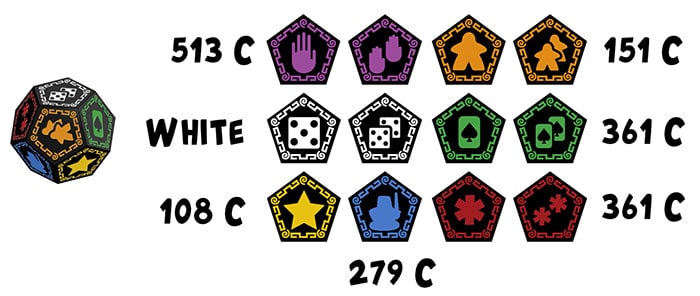
When you make custom dice, each of the different faces of the dice can be painted in a different color. This also helps tremendously in differentiating between the different dice faces and the various functions each dice face has in the game.
For our resource dice, we had some icons that were different but belonged to the same type, so we painted those in matching colors. For painting the different colors of the dice faces, we use standard pantone colors. You can get pantone color books at artshops to help you understand how the color would look like in real life! Please include the pantone color number somewhere in the design file when you send it to your account manager. This way we can make sure that each dice face gets painted in the right color.
The other thing to keep in mind when selecting colors, is that not all colors work together as well as you might hope. Depending on what color you make the base, you might find that some colors might not come out as bright and popping as you hoped, or as distinguishable. If you are unsure about certain color combinations, we can always advise you on it based on our plethora of experience so don’t hesitate to reach out!
The “machinery dice” – Engraved 6 sided dice
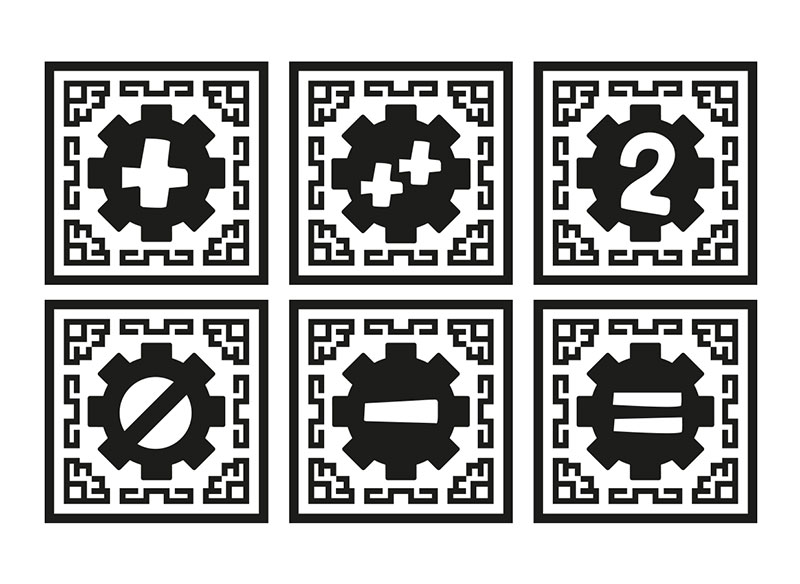
The next design from our sample box game “The Manufacturer’s Race” is the “machinery dice.” The machinery one has a design that is inspired by gears and machines. The machinery one is also a resin-molded dice, like discussed before, but made from a different base material. This one is made from a pearl base material, that gives it a very attractive marbled texture. Making it very popular among board games and board gamers alike!
As the main focus point of the machinery design was the beautiful pearl texture, the designs were done in black and white patterns. We use Adobe Illustrator to make the designs. But any software you are familiar with can be used. As long as it can output in a file format that we can read. The main point was to have the design simple and effective, but still visually interesting.
For this dice, we decided on a golden paint rather than use a pantone color. The golden paint contrasts beautifully with the dice base color. And adds to the luxury feeling by combining the pearl finish on the base material with the golden accents and touches on the patterns.
The “action dice” – Silk screened 6 sided dice

The third and last one in our sample box is one we call the “action dice.” The action dice combines with other parts of the game for some of the more interesting game mechanics. To accurately convey these game mechanics, we needed more complex patterns on the dice faces.
When you want to show a more detailed image, you can use something called silk printing. A silk printed dice is one where an image is silk-printed, or in other words transferred, directly onto the surface of the die face. This allows for more complex images with fine details. And is perfect for design that struggle with some of the limitations of molded ones. These include things such as thin lines or heavy grouping of details. Or multiple colors within the same image. Another advantage is that the manufacturing cost is lower than that of a molded dice with custom dice faces.
Although silk screen printing on the die face allows for more complex designs. It is still recommend not to have too many colors per design. The more colors you use, the higher the price will get. Furthermore, it increases the chances that the image will be less sharp. For our design, we stuck to 4 color tones for the color selection.
So many options…
The three dice we put in our sample box that we discussed in this article are merely the starting point. There are so many different options you have when it comes to dice. Boda Games is proud to offer a huge variety of manufacturing options and solutions. Colors, paints, shapes, sizes and more. You name it and we can help you find the optimal way to manufacture it. Do you have any ideas for dice that you’re not sure how to best approach in terms of manufacturing? Don’t hesitate to reach out to us! We will gladly bounce ideas back and forth and help come up with ideas.
For further information about dice, also have a look at our artwork guidelines section that is filled with advice and information on this topic. And while you’re there, check out all the other guides we wrote about other board game components as well!
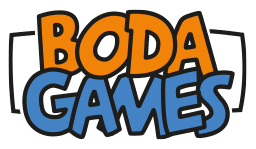


Sorry, the comment form is closed at this time.